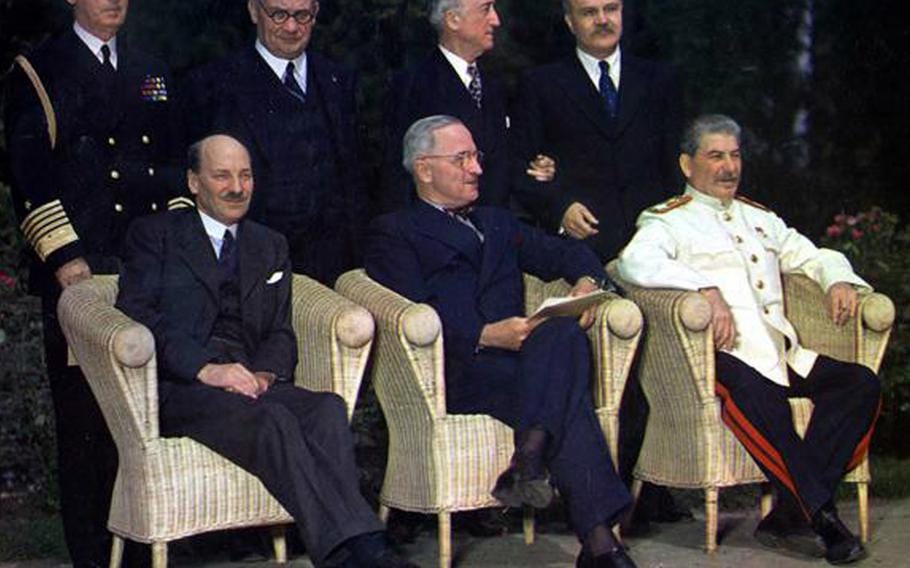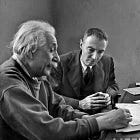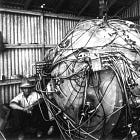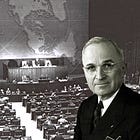Soon after using the bomb, President Harry Truman began wrestling with how to control it. “The hope of civilization,” he said in his message to Congress in October 1945, “lies in international arrangements looking, if possible, to the renunciation of the use and development of the atomic bomb.”
In international relations, as in domestic affairs, the release of atomic energy constitutes a new force too revolutionary to consider in the framework of old ideas. We can no longer rely on the slow progress of time to develop a program of control among nations. Civilization demands that we shall reach at the earliest possible date a satisfactory arrangement for the control of this discovery, in order that it may become a powerful and forceful influence toward the maintenance of world peace instead of an instrument of destruction
In November 1945, Truman advanced the first government non-proliferation plan when he joined with British Prime Minister Clement Attlee and Canadian Prime Minister Mackenzie King to propose to the new United Nations that all atomic weapons be eliminated and that nuclear technology for peaceful purposes be shared under strict international controls, implemented by a U.N. Atomic Energy Commission.
By 1946, he had a detailed plan that included many of the nuclear nonproliferation proposals still debated today, including a ban on the production of any new weapons or the fissile material for weapons, international control of nuclear fuel, a strict inspection regime, and total nuclear disarmament.
Truman was not alone in considering new policies that might be able to stop the spread of this terrible new weapon. In fact, the origins of this first U.S. plan can be found in the troubled conversations some atomic scientists held in the closing days of the war.
Franck Warning
A-bomb research was conducted primarily in Los Alamos, while scientists at the Manhattan Project’s Metallurgical Laboratory in Chicago focused on the production of fissile materials that would form the core of the explosive device. In December 1942, the first test nuclear reactor went critical in the squash courts under the stadium at the University of Chicago. While Los Alamos raced to finish the bomb, by the spring of 1945 work at Chicago had slowed and scientists were drawn to thoughts of the future.
That June, when the defeat of Nazi Germany eliminated the major reason why many of the scientists had rallied to the atomic project, Chicago physicist and Nobel laureate James Franck formed a committee to consider the implications of the bomb. It included Eugene Rabinowitch, the ultimate drafter of the report (and later that year a founder of the Bulletin of the Atomic Scientists) and Leo Szilard, who agonized about its use on Japan after Hitler’s defeat. They were increasingly concerned about the uncontrolled spread of atomic energy and the moral implications of using the atomic bomb.
Just as Truman’s non-proliferation plan would do a year later, their mid-1945 report, known as the Franck Report, presaged the major proliferation concerns that would soon become so crucial in international affairs.
The scientists warned that the United States could not rely on its current advantage in atomic weaponry. Nuclear research would not be an American monopoly for long, and secrecy would not mean protection. Staying ahead in production was also a false source of security, since a “quantitative advantage in reserves of bottled destructive power will not make us safe from sudden attack.” If no international agreement were developed after the first detonation of the bomb, they concluded, then there would be a “flying start of an unlimited armaments race.”
Nuclear bombs cannot possibly remain a “secret weapon” at the exclusive disposal of this country, for more than a few years. The scientific facts on which their construction is based are well known to scientists of other countries. Unless an effective international control of nuclear explosives is instituted, a race of nuclear armaments is certain to ensue following the first revelation of our possession of nuclear weapons to the world. Within ten years other countries may have nuclear bombs, each of which, weighing less than a ton, could destroy an urban area of more than ten square miles.
The Franck report also argued that the use of the bomb on Japan without warning would have both moral and political repercussions:
“It will be very difficult to persuade the world that a nation which was capable of secretly preparing and suddenly releasing a weapon, as indiscriminate as the rocket bomb and a thousand times more destructive, is to be trusted in its proclaimed desire of having such weapons abolished by international agreement.”
Rather than immediately drop the bomb, they contended, there should be a technical demonstration of its enormous explosive power to warn the Japanese of what would happen if they failed to surrender.
After a discussion of the Franck report in mid-June, the Interim Committee decided that the technical demonstration pushed by the scientists would not convince Japan to surrender. It did not seriously consider the recommendations on international control of atomic energy. Truman never saw the report.
But the Chicago scientists had hit upon a core truth: preventing proliferation had to be a universally accepted political solution; the science of nuclear technology could not be otherwise contained. They could not have been more clear:
“We urge that the use of nuclear bombs in this war be considered as a problem of long-range national policy rather than military expediency, and that this policy be directed primarily to the achievement of an agreement permitting an effective international control of the means of nuclear warfare.”
Enter Baruch
This impulse found new life after the war. The Truman-Attlee-King proposal to form a commission was adopted by the United Nations in December 1945. On June 14, 1946, the United States representative to the commission, conservative financier Bernard Baruch, presented the nation’s detailed recommendations. At the United Nations, Baruch was nothing if not dramatic. “We are here to make a choice between the quick and the dead,” he said. “That is our business. . . . If we fail, then we have damned every man to be the slave of fear.”
Since the objective of the Baruch Plan was not only to restrain the spread of nuclear weapons, but also to prevent an arms race and eliminate the bomb altogether, it proposed that once the International Authority could ensure that no other state was able to construct the bomb, the United States would guarantee the elimination of its entire nuclear stockpile.
Approved by the U.N. Atomic Energy Commission on December 31, 1946, the plan was opposed by the Soviet Union in the U.N. Security Council. Stalin saw the bomb as more than a weapon. It was also a symbol of industrial might, scientific accomplishment, and national prestige. Stalin told his scientists, “Hiroshima has shaken the whole world. The balance has been broken. Build the Bomb—it will remove the great danger from us.”
Stalin was not about to accept any plan that limited Soviet national sovereignty and that might have locked in, even if only for a short time, America’s nuclear advantage. Knowing that the Americans would refuse, the Soviets proposed that any agreement require Washington to disarm prior to the establishment of some form of international authority.
Stalin was right. Truman and Baruch would not compromise. There was a growing sense among prominent American officials that the United States should retain a nuclear monopoly.
Leslie Groves argued that the Soviets would not be able to build the bomb for one to two more decades. Secretary of State James Byrnes saw the bomb as a trump card in meetings with Stalin and Soviet Foreign Minister V. M. Molotov. Even Baruch came to believe that the plan could only be accepted on its own terms since “America can get what it wants if she insists on it. After all, we’ve got it and they haven’t.”
The combination of Soviet opposition and growing faith in the sustainability of American superiority proved too much for the Baruch Plan. For a brief time in 1946, this revolutionary vision to abolish the ultimate weapon seemed within reach. In a matter of months, it was defunct.
A Bomb for Russia
Historian David Holloway and others argue persuasively that even if Truman had followed physicist and Nobel laureate Niels Bohr’s advice to tell the Soviets about the bomb before it was built, Stalin would still have pursued a Russian bomb. “As the most powerful symbol of American economic and technological might, the atomic bomb was ipso facto something the Soviet Union had to have too,” Holloway writes. (Stalin and the Bomb, p. 131.) In fact, by the time of the Baruch Plan, Russia was seriously committed to her atomic bomb project.
The Soviet effort commenced with little fanfare in 1943. Stalin did not expect the bomb to be ready in time to influence the war with Germany, and the nuclear program was instead started as “a rather small hedge against future uncertainties.” (Holloway, p. 94)
The head of the Soviet project, physicist Igor Kurchatov, struggled to attain both the fissile materials and the political support necessary to speed up development of the bomb. Even in the spring and summer of 1945, Stalin remained skeptical. When Truman cryptically mentioned a “new weapon of unusual destructive force” at the Potsdam Conference in July 1945, Stalin most likely understood the atomic bomb reference. But the reality of the weapon as a tool of both destruction and diplomacy was not apparent to Stalin until the bombing of Hiroshima and Nagasaki. (Holloway, p. 122)

Moscow’s effort was greatly accelerated following the end of World War II. Stalin was determined, and he spared no expense, telling his nuclear scientists, “Ask for whatever you like. You won’t be refused.”
Thrown full force into a greatly expanded nuclear program, Soviet scientists knew they were several years behind the Americans. But they also had a significant advantage: the U.S. had shown it could be done. The American design, while not the most efficient, was successful, and the Soviet Union did not have time to take chances. Soviet intelligence provided scientists with the key elements of the American bomb design.
But as the source of the bomb design was kept secret, experimental results had to be reconstructed and steps retraced. Apart from Kurchatov and a few other select members of the project, Soviet physicists did not know they were working on copied designs.
It took the U.S.S.R. four years to catch up, achieving the bomb in almost the exact same time it took the U.S. The first Soviet nuclear test took place on August 29, 1949. The test was set up in remote Kazakhstan, at a site known as Semipalatinsk-21. The area around the settlement, later renamed after Kurchatov, was to be the site of over 450 nuclear tests through the course of the Cold War.
An Atomic Edge?
The American monopoly was over. For Stalin, the bomb wasn’t a threat to all of humanity, but rather a source of security and power. Truman saw it more than ever as a tool to contain Stalin and preserve American security. He ordered a rapid increase in the then small U.S. atomic arsenal.
Atomic weapons were becoming the currency of power. Policy was increasingly influenced by the strong belief in the diplomatic utility of these new weapons.
This view retains a powerful hold on policy makers in many countries today. It began early on, as some within the U.S. government argued that dropping the bomb on Japan would also have a deterrent effect on the Soviet Union.
The Soviets understood this, but did not respond as predicted. Molotov said years later that the Soviets rejected the Baruch Plan because they believed that the bombs dropped on Japan “were, of course, not against Japan but against the Soviet Union: ‘See, remember what we have. You don’t have the atomic bomb, but we do—and these are what the consequences will be if you stir.’ Well, we had to adopt our tone, to give some kind of answer, so that our people would feel more or less confident.”
The idea that political power comes from the barrel of a gun-assembly fission bomb took hold in both American and Soviet policy. Even James Conant, the president of Harvard who had overseen the Manhattan Project and was a voice for nuclear restraint, wrote Henry L. Stimson in 1947,
“I am firmly convinced that the Russians will eventually agree to the American proposals for the establishment of an atomic energy authority of world-wide scope, provided they are convinced that we would have the bomb in quantity and would use it without hesitation in another war” (emphasis in original).
But Conant was wrong. The American shift to more and bigger bombs did not convince the Soviets to forgo their own arsenal. Instead, it encouraged Moscow to respond in kind.
To be continued…..
This is the conclusion of my five-part series on the science, history and politics of the beginning of the nuclear age, based on my book, Bomb Scare: The History and Future of Nuclear Weapons (Columbia University Press, 2008). I hope you will see the Oppenheimer film and read the other chapters in this story:









